Title: How to Identify AI-Generated Images: A Guide for the Layman
In today’s digital age, the use of AI-generated images has become increasingly prevalent. With advancements in artificial intelligence and machine learning, it has become harder for the average person to distinguish between images created by humans and those generated by machines. This raises concerns about the authenticity and accountability of visual content on the internet and in various media platforms.
Whether it’s for the purpose of combating fake news, verifying the legitimacy of photographs, or even just satisfying one’s curiosity, the ability to identify AI-generated images has become an essential skill. In this article, we will discuss some key indicators and techniques that can be used to identify the origin of images in a world where AI continues to blur the line between reality and simulation.
1. Pixelation and Artifacts:
One of the most common indicators of AI-generated images is the presence of pixelation or other visual artifacts. AI-generated images may exhibit unnatural patterns or inconsistencies in the visual data, especially in areas where the AI algorithm struggled to accurately replicate real-world details. Look for areas of the image that appear blurry, distorted, or exhibit unusual patterns and textures.
2. Unnatural Perspectives and Proportions:
AI-generated images may sometimes feature perspectives or proportions that are physically impossible or unlikely to occur in real life. This could be due to the limitations of the AI model in understanding spatial relationships and the physical constraints of the real world. Pay attention to any distorted or unrealistic elements in the composition of the image.
3. Repetitive Patterns and Symmetry:
AI algorithms often rely on patterns and repetitions in data to generate images. As a result, AI-generated images may display an unnatural level of symmetry or repetition in specific elements, such as textures, shapes, or colors. Look for signs of excessive uniformity or perfectly symmetrical details that are unlikely to occur naturally.
4. Metadata and Source Information:
When attempting to identify the authenticity of an image, checking the metadata and source information can provide valuable clues. Analyze the file properties of the image to determine if it has been manipulated or generated by an AI tool. Additionally, consider the context in which the image was found and investigate the credibility of its original source.
5. Cross-Referencing with Known Datasets:
Given the widespread use of AI-generated images for various applications, it is common for datasets of AI-generated images to be publicly available. By cross-referencing an image with known datasets, such as those used to train AI models, it may be possible to identify if an image has been generated by a machine.
In conclusion, the ability to identify AI-generated images is becoming increasingly important as AI technology continues to progress. By paying attention to visual anomalies, leveraging technical knowledge, and being critical of the source and context of images, it is possible to develop a discerning eye for distinguishing between authentic and AI-generated visuals. As AI continues to influence the images we encounter, being able to critically evaluate the content we consume is an essential skill in the digital age.
